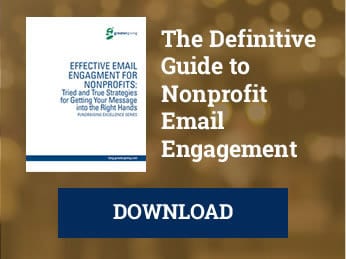
This post is the first in a series designed to teach the fundamentals of email marketing for nonprofits. These posts are based on the Effective Email Engagement for Nonprofits: The definitive guide to better nonprofit email marketing. Each post focuses on an element of conducting an email marketing campaign, from crafting email to measuring recipient responses and adjusting your email approach accordingly.
Why Email?
More people respond to email than any other method of digital communication. According to M+R’s Benchmarks Study, online giving is growing.
26% of nonprofits’ online revenue in 2016 came through email.
Besides the stats, email is a great way to reach people unguarded. Checking email is considered a “complementary activity”—meaning that your subscribers do it while doing lots of other normal, daily-life kind of things.
Watch TV and check email. Eat lunch at work and check email. Check email while commuting by train. We’ve all done it.
Getting access to someone’s email inbox is like getting an exclusive channel into their private life. Send the right email at the right time, and be the thing that pops up when they’re relaxing at home or taking a break from life at the office.
Make Your Email an Experience, Not a Chore
So how do you best capitalize on email as a complementary, passive, relaxing activity?
Make your email engaging. Don’t treat your recipients as piggy banks—but as people you want to interact with.
And what do people find most interesting?
#1: Stories
 Humans love stories. We frame most things in our lives in story format—with heroes, villains, obstacles and happy endings.
Humans love stories. We frame most things in our lives in story format—with heroes, villains, obstacles and happy endings.
Right now, 15 million children in the United States live in poverty.
This is a good starting point—where you’re at now, and why that state of being needs to change. The villain in a nonprofit story isn’t always a person, and that’s okay! Poverty, homelessness, or a lack of access to clean drinking water can be your villains to be conquered.
Next, set the stage for your nonprofit’s work.
Studies show that children living with food anxiety struggle more in school.
And that’s where you come in. Now that you’ve pitched a problem, it’s time for a solution. You’re giving your readers a reason for doing the work that you do, and that reason is what will keep them reading.
Our nonprofit helps feed over 5,000 children every year. That means more kids doing better in school and having bright futures.
This is what your nonprofit does to change that dissatisfactory status quo—and why it’s so important that your recipient support your work!
Be sure to make a straightforward, clear call to action, so your recipient knows how to help.
One $20 donation can feed a whole family in poverty for two days.
Finish off by clearly show how your recipient’s action will directly work toward positive change.
#2: Engage closely and get personal
Don’t be afraid to write to your email list like you’d write to a friend. For some demographics, formal language can be a big turn-off, and certainly doesn’t help your reader feel as close to the issue as you want them to be.
Bring your recipient into the fold with your writing!
- Make it accessible: Digestible, simple vocabulary
- Make it fun: Don’t shy away from a joke where it’s appropriate (we want to entertain!).
- Fill it with personality: Give your reader a sense of your nonprofit’s style and what you’re about.
#3: Photos and video
Have you ever opened a textbook and been intimidated by the big blocks of text?
Nobody’s going to find a long email filled with laborous text very enjoyable—so break it up!
Use pictures to illustrate your points. Photos and video, particularly, let your reader connect on a deeper level with your story and your mission. Show the work that your nonprofit is doing, whether it’s building homes for the homeless, or providing students with a specialized education.
Well-placed pictures let your reader can associate your call to action with an image—or better yet, with a face.
Don’t forget the power of a great video, either, in showing your nonprofit at work. Tell a story with your video. Convince your audience that not only are you out there trying to change the world for the better, but with their help, you can succeed at it.
#4: Make recipients feel important and special
I don’t know about you, but here’s a thought I’ve had whenever I read a nonprofit story: Will my $20 donation really matter?
Express how donations just like these have made a huge difference in the past—and how it can again in the future. Tell your recipient you need them, and so does your cause. Focus on how generous they are!
People want to live up to expectations. If you say they’re generous and giving, they’ll be more likely to be generous and giving!
And always, when crafting email for your subscribers, think about how much they’ll want to read in one sitting.
Remember: email is a complementary activity! Make your message as long as a bathroom break, and you won’t lose your subscriber’s attention before they reach your call to act.
